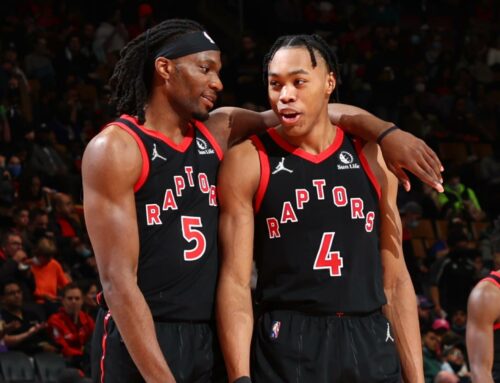More and more the NBA’s popularity is driven by highlights and superstars. Blame NBA marketing. Blame social media. Blame our dying attention spans. Whatever. I am not here to judge.
The point is, that the atomization of NBA entertainment – a reliance on individual performances and exciting singular moments or plays – leaves us naturally building a tolerance towards the “normal”; our brains crave the next bedazzling experience.
Which means that we tend to overlook the understated. We fail to appreciate players contributing in a less heralded fashion. Something I talked a bit about last week.
I was watching a random Indiana Pacers game the other day. And noticed Timothy John (universally known as T.J.) McConnell picking a Chicago Bulls player up full court…early…in the second quarter.
To say this is highly irregular in an NBA game is a gross understatement. Even in the dying seconds of a tightly contested playoff game, teams rarely full court press. They’ll do it to foul, or to try and squeeze out a turnover and then foul. But you’ll never see a full-court press scheme.
I can guess Indiana does not have a full-court scheme either. Just T.J. does.
Watching him score a lay-up while in the same motion swoop back inbounds to magnetically lock onto the opposing ball handler’s hip and ride him all the way down the court harkens back to an older generation.
An earlier era of the NBA that was much grittier, uglier, but grittier. T.J. reminded me of guys like Avery Johnson, Eric Snow, and even Derek Fisher who were smaller, pass-first, defensively-minded point guards playing important, but subsidiary roles.
Now, the game’s evolved. There’s little room for traditional point guards who can’t shoot or create.
And, yet, there’s T.J., the 6’1 point guard with limited explosiveness and physical qualities (he measured with the smallest hands, second-shortest wingspan, and one of the lowest max vertical leaps at the 2015/16 draft combine), no three pointer, and a below average effective field goal percentage playing meaningful minutes for a winning Indiana Pacers team.
His contributions are at the same time anachronistic and ageless. I can picture him flying around in one of those 1950s runs (that might have something to do with him being short and white), getting into fights with Isaiah Thomas in the late 80s, jawing it up with Gary Payton in the 1990s, and causing Steve Nash and Jason Kidd unending grief in the Aughts in the same way I watched him haunt those Chicago Bulls guards all game.
If we want to fit him to an archetype of today, there are only two other players in the league who average more minutes (23) and less points (6) than T.J.: P.J. Tucker and Draymond Green.
Like those two – he’s more Dray than P.J. – T.J. functions as the team’s interstitial muscles. He preserves the second unit’s offence and strengthens its defence.
T.J. fills a role seldom asked of players these days: doing the dirty work; making the extra pass; hustling on each and every play. The kinds of effort expected more in the NHL than the NBA.
Which is maybe a more apt comparison for T.J.. He is more hockey than basketball, gliding around causing chaos and creating scoring opportunities, just like some hoser on the ice. Which is basically what got him to the NBA in the first place.
T.J. went undrafted in 2015 and was signed by the Philadelphia 76ers in the midst of the Hinkie-”Trust the Process” era. A time where Philly was using a CBA loophole to scout and exploitatively sign potential talent – Robert Covington’s first contract serves as Exhibit A. Throughout that carousel of auditioning players, McConnell stuck.
His rookie year they went 10-72 and he averaged, well, the exact same numbers as this year. He oddly – you’ll have to ask Sam himself – met a balance between Hinkie’s desire to passively forfeit every game and being a legitimate NBA player. Whatever the algorithm, his intensity and determination kept him around.
At first, it seemed as though McConnell, despite his best efforts, was a stand-in at a dress rehearsal. Just there to fill up minutes loss after loss after loss. But it became evident in the subsequent years, as Philly evolved into a playoff team, that T.J.’s style of play contributed to winning basketball. And that, win or lose, T.J. is going to give you exactly everything T.J.’s got.
(Notice how his stats are all basically, absolutely, totally the same)
Hustle and Flow
T.J. knows that he’ll never have gaudy numbers – he doesn’t. He knows he’s not going to be the go-to-guy on a winning team – he isn’t. Instead, he recognizes that his value comes entirely from outworking everyone else on the court.
He said it himself in a recent post-game interview,“…honestly, as long as we win…I just want to help our team win in any way that I can.”
And so he does.
This year, T.J. is the second fastest player in the NBA (fastest on defence) for those who have played at least ten games this season for fifteen minutes or more per game. For players who average less than 25 minutes a game, T.J. is first in distance ran per game. This all means that – yes, you figured it out – T.J. runs the longest distance at the fastest pace in the entire league.
Which, if you watch him for, like, thirty seconds you won’t be surprised one bit. This play below is dead. There’s not a Pacer in sight except for T.J. sprinting headlong into the bench, past a jogging Kyle Lowry to maybe get a ball heading out-of-bounds and, impossibly, try and save it for teammates who’ve already vacated that half of the court.
The real distance is accrued through T.J.’s constant full court press. Every…single…possession – even after plays where he’s scored – there he is back on the saddle.
On this transition play, T.J. floats a nice pass to Goga Bitadze and immediately locks in to pre-empt a semi-fast break. This is particularly important because his man carrying the ball is Lonzo Ball who is most dangerous running in open court.
He prevents Lonzo, again, after a saucy lay up. But this time, he shadows Lonzo forcing the inbounder to pass to Nickeil Alexander-Walker, the lesser ball-handler. Then he shrouds NAW. It’s as though T.J. is thinking of the game in one singular possession with a zero latency period between offence and defence.
Offence Deference
T.J.’s modus operandi is pass first. He wants to get his fellow scorers the ball ASAP. He does this in a very Steve Nashian way. He attacks and probes defences by using his lateral quickness and low-centre of gravity to craftily get into the paint. From there, like Steve, he let’s the other nine players do the decision-making for him.
If they lay off him, T.J. will go to the rim or take a little jumper, if they don’t, he’s searching out the right pass, which he does efficiently. He is twelfth in the league in assists and fifteenth in assists leading to points. He’s also second in the league in assists per 100 possessions and fourth in assists per 36 minutes.
Here you see how, again like Steve, he never picks up his dribble until the exact opportunities present themselves.
His constant movement and selflessness gives Indiana greater flow to its offence. According to PBP Stats, the Pacers score six more points off assists and score two more points per one hundred possessions when T.J. is on the court.
Defend It All
The real T.J. Experience is on defence. It’s kind of sad, but his effort and determination stands out so starkly compared to how most NBA players play. He really is a college kid in an NBA setting. He does not stop. Ever. End-to-end, second-to-second, T.J. is there, in their shorts. You saw that above in his full court press.
He’s not there just to be a nuisance either. His oppressive defence forces turnovers and disrupts offences. He’s third in the league in steals despite playing at least eight minutes less than the other nine top thiefs. He also happens to be first in the league in defensive loose balls recovered per game and seventh in deflections.
Thanks to his hard work, the Pacers allow seven fewer points per one hundred possessions when T.J. is on the court.
I’ll let the footage do the rest of the talking. Remember that hounding of Chicago Bulls guards I was talking about earlier. Watch poor Coby White try and not get away.
For good measure, here’s two minutes of T.J. McConnell swiping steals in the backcourt should you so choose to enjoy.
It brings me great joy to celebrate a player like T.J.. Not because I am some curmudgeon who thinks the NBA has lost its edge. Quite the contrary. This game is full of supremely gifted and athletic players who bring it night in and night out.
But at times, the NBA feels distant. As though these players are so far from the realm of reality in size and speed and skill that I cannot compute their greatness.
Then comes along all six feet of the T.J. McConnell Experience.
He reminds us that basketball is not just about being the silkiest shooter or tightest ball handler, but about sound defensive principles and tireless effort. He reminds us that athleticism is not only being the fastest, tallest, or highest jumper, but can be about constant movement, proper footwork, and an unrelenting motor.
He reminds us that at whatever level of basketball we play at, the game is nearly as much about discipline and effort as it is any other physical quality. And, for that, he makes the NBA all the more relatable and enjoyable to watch.





